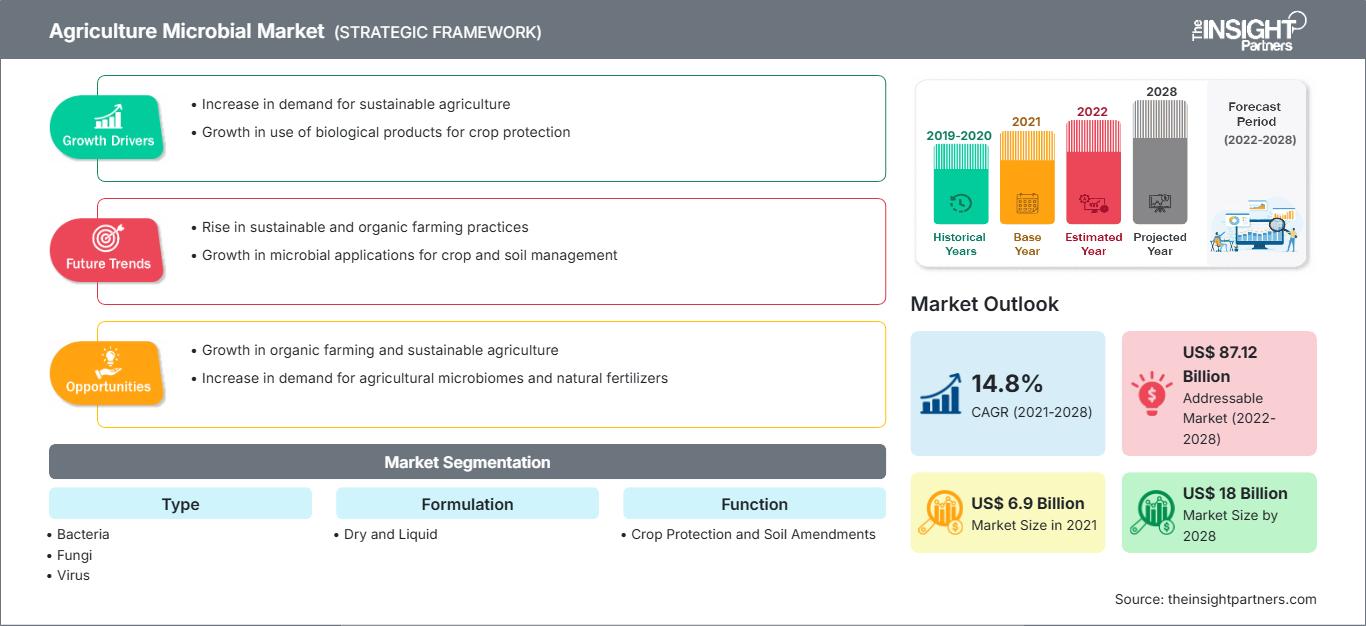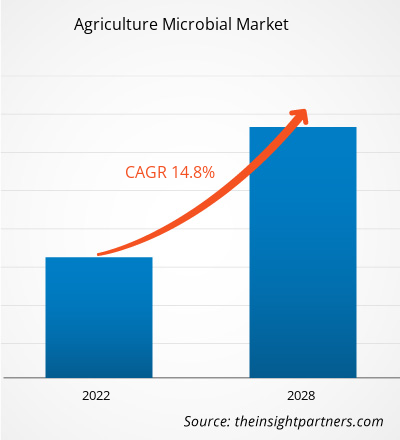The Insight Partners에 따르면 농업용 미생물 시장은 2021년에 69억 193만 달러 규모였으며, 2022년부터 2028년까지 연평균 성장률 14.8%로 성장할 것으로 예상됩니다.
농업용 미생물은 농업에서 작물 생산성과 수확량 품질을 향상시키기 위해 사용되는 미생물을 말합니다. 박테리아, 곰팡이, 바이러스는 미생물의 일종입니다. 이들은 영양분 접근성을 높여 식물 생장을 촉진할 수 있습니다. 많은 미생물이 유기물 분해 및 농업 폐기물 재활용에 도움을 줍니다. 또한 인, 질소 및 기타 영양소를 제공하고 내열성, 내한성, 내병성 등의 이점을 제공합니다.
2020년 북미는 세계 농업용 미생물 시장에서 가장 큰 점유율을 차지했으며, 아시아 태평양 지역은 예측 기간 동안 가장 높은 연평균 성장률을 기록할 것으로 예상됩니다. 북미는 농업에서 합성 화학물질 대신 미생물을 사용하는 것의 이점에 대한 인식이 높아지면서 시장에서 가장 중요한 지역 중 하나입니다. 합성 화학물질은 해충 저항성을 키우고 작물 생산에 해를 끼치기 때문에 효과가 없습니다. 농업용 미생물은 실용적이고 소량만 사용해도 빠르게 분해되어 노출을 줄이고 합성 화학물질로 인한 환경 문제를 예방할 수 있습니다. 또한, 친환경 및 유기농 재배 관행의 증가는 미생물 농업 시장의 성장을 촉진하고 있습니다. 미국 농무부(USDA)의 2019년 유기농 조사에 따르면, 2019년 미국 내 유기농 농장 수는 16,585개로 2016년 대비 16.7% 증가했습니다.
이 보고서의 일부, 국가 수준 분석, Excel 데이터 팩을 포함하여 모든 보고서에 대한 사용자 정의를 무료로 받을 수 있을 뿐만 아니라 스타트업 및 대학을 위한 훌륭한 제안 및 할인을 이용할 수 있습니다
농업 미생물 시장: 전략적 통찰력

-
이 보고서의 주요 주요 시장 동향을 확인하세요.이 무료 샘플에는 시장 동향부터 추정 및 예측에 이르기까지 데이터 분석이 포함됩니다.
COVID-19 팬데믹 이전에는 유기농업 도입 증가와 지속 가능한 농업에 대한 수요 증가가 농업 미생물 시장을 주도했습니다. 그러나 2020년 팬데믹으로 인해 많은 산업이 전례 없는 어려움에 직면했습니다. 여러 제조 시설의 폐쇄와 공급망 차질로 농업 산업이 침체되었습니다. 그러나 2021년, 각국 정부가 기존 제한 조치를 완화하면서 여러 국가에서 생산을 재개했고, 이는 세계 시장에 긍정적인 영향을 미쳤습니다. 또한 제조업체들은 최대 가동률을 허용받아 수요와 공급의 불균형을 극복할 수 있었습니다. 현재 시장 상황은 이전보다 훨씬 나아졌습니다. 많은 국가가 백신 접종을 완료했으며, 농업 미생물 제품 제조업체들은 매출 증대를 위해 생산량 증대에 주력하고 있습니다.
제조 시설의 노동력 부족과 그에 따른 봉쇄 조치 및 매장 폐쇄로 인한 유통업체 및 소매업체를 통한 현장 판매 중단은 농업 미생물 시장의 성장을 저해했습니다. 코로나19 팬데믹으로 큰 타격을 입었음에도 불구하고, 여러 기업들은 2020년 말까지 지속가능한 농산물에 대한 수요가 증가했다고 보고했습니다. 그러나 농산물 부족 현상이 심화됨에 따라 각국 정부는 식량 수요를 충족하기 위해 농산물 규제를 완화했습니다.
시장 분석: 유기농업 도입 증가로 농업 미생물 시장 성장
지난 몇 년 동안 유기농업은 지속가능성을 확보하고 환경에 미치는 악영향을 줄이기 위해 전 세계적으로 도입되어 왔습니다. 토양 침식 감소, 지하수 및 지표수로의 질산염 침출 감소, 그리고 농장 내 가축 배설물 재활용 등은 유기농업의 이점 중 일부입니다. 이러한 이점에 대한 인식이 높아짐에 따라 유기농업에 대한 수요가 급증했습니다. 미국 농업통계청(NAS)이 실시한 2019년 유기농 조사에 따르면, 미국에서는 2016년부터 2019년까지 유기농 인증 농가가 17% 증가했습니다. 유엔 식량농업기구(FAO)에 따르면, 2019년 기준 187개국에서 유기농업이 시행되고 있으며, 약 7,230만 헥타르의 농지가 유기농으로 관리되고 있습니다. 개발도상국의 여러 국가에서는 유기농업 도입을 강력히 권고하고 있습니다. 농업 미생물은 합성 성분으로 대체될 수 없기 때문에 토양 관리에 있어 유기농업에서 중요한 역할을 합니다. 박테리아, 곰팡이, 바이러스를 포함한 토양 미생물은 작물 잔류물 분해, 질소와 탄소와 같은 필수 영양소 순환, 식물 생장 촉진 등 토양에서 근본적인 기능을 수행합니다. 따라서 유기농업 도입 증가는 유기농업에서의 이점으로 인해 농업용 미생물에 대한 수요를 촉진합니다.
유형별 분석
농업용 미생물 시장은 유형에 따라 박테리아, 균류, 바이러스 등으로 구분됩니다. 박테리아 부문은 예측 기간 동안 가장 큰 시장 점유율과 가장 높은 연평균 성장률을 기록할 것으로 예상됩니다. 균류는 유기물을 분해하고 폐기물을 재활용하는 데 필수적인 토양 미생물 중 하나입니다. 또한 수분 역학, 영양소 순환, 질병 억제와 관련된 필수적인 기능을 수행합니다. 예를 들어, 균류 균사는 토양 입자와 물리적으로 결합하여 안정적인 응집체를 형성하여 식물의 토양 보수력과 수분 침투를 증가시킵니다.
제형별 분석
제형에 따라 농업용 미생물 시장은 건식 및 액상 미생물로 구분됩니다. 액상 부문은 예측 기간 동안 더 큰 시장 점유율을 차지할 것으로 예상되는 반면, 건식 부문은 2021년부터 2028년까지 더 높은 연평균 성장률(CAGR)을 기록할 것으로 예상됩니다. 액상 부문 시장은 적용 편의성 덕분에 성장하고 있습니다. 액상 제품은 관주, 분무, 뿌리 침지 등 다양한 방법으로 직접 사용할 수 있어 건식 농업용 미생물보다 편리합니다. 또한, 혼합과 같은 추가 절차가 필요하지 않아 제품의 부패 및 낭비를 방지할 수 있습니다.
기능 분석
농업용 미생물 시장은 기능에 따라 작물 보호와 토양 개량으로 구분됩니다. 작물 보호 부문은 2020년에 더 큰 시장 점유율을 차지했습니다. 농업용 미생물은 뿌리, 씨앗, 과일 및 기타 작물의 부분을 보호하는 데 사용할 수 있습니다. 작물 보호 제품은 소규모 재배 면적의 생산량 증가, 환경 보호, 수확량 증가, 식량 가격 하락 등 다양한 이점을 제공합니다. 이러한 장점 덕분에 작물 보호 제품 도입이 증가했습니다. 미생물 해충 방제는 생태학적 안전성과 상당한 표적 특이성을 제공하므로 해충 관리 프로그램이 선호됩니다.
적용 방식 통찰력
적용 방식을 기준으로 농업용 미생물 시장은 엽면 살포, 토양 처리, 종자 처리, 수확 후 처리로 구분됩니다. 엽면 살포 부문은 2020년 시장 점유율이 가장 높았습니다. 엽면 살포를 통해 적용된 영양소는 다른 기법보다 흡수 속도가 빠릅니다. 엽면 살포는 인건비와 기계 비용을 절감하여 작물 생산 비용을 최소화하는 데 도움이 됩니다. 이러한 기법은 식물의 결핍 및 질병을 신속하게 교정하는 데 효과적입니다.
작물 유형 통찰력
작물 유형을 기준으로 농업용 미생물 시장은 곡물, 유지 종자 및 콩류, 과일 및 채소, 기타로 구분됩니다. 과일 및 채소 부문은 2020년 가장 큰 시장 점유율을 기록했습니다. 이 부문의 시장 성장은 작물과 관련된 높은 수익 요소와 필수 영양소를 효과적으로 공급해야 하는 수요 증가에 기인합니다. 또한, 유기농 과일 및 채소에 대한 수요 증가는 농업용 미생물에 대한 수요를 촉진합니다. BASF SE, Bayer AG, Certis USA LLC, BioWorks, Novozymes A/S, Chr. Hansen Holding A/S, Syngenta Group, Nufarm, Marrone Bio Innovations, Inc., Koppert BV는 농업용 미생물 시장의 주요 기업입니다. 이 기업들은 전 세계적으로 증가하는 소비자 수요를 충족하기 위해 신제품 출시와 지역 확장에 주력하고 있습니다. 전 세계적으로 광범위한 입지를 확보하여 전 세계 다양한 고객에게 서비스를 제공하고 시장 점유율을 확대하고 있습니다. 이러한 시장 참여 기업들은 신제품 출시와 지역 확장에 집중하여 특수 제품군을 확대하고 있습니다.
농업 미생물 시장 지역별 통찰력
The Insight Partners의 분석가들은 예측 기간 동안 농업 미생물 시장에 영향을 미치는 지역별 동향과 요인들을 면밀히 분석했습니다. 이 섹션에서는 북미, 유럽, 아시아 태평양, 중동 및 아프리카, 그리고 중남미 지역의 농업 미생물 시장 부문 및 지역별 현황도 다룹니다.
농업용 미생물 시장 보고서 범위
| 보고서 속성 | 세부 |
|---|---|
| 시장 규모 2021 | US$ 6.9 Billion |
| 시장규모별 2028 | US$ 18 Billion |
| 글로벌 CAGR (2021 - 2028) | 14.8% |
| 이전 데이터 | 2019-2020 |
| 예측 기간 | 2022-2028 |
| 다루는 세그먼트 |
By 유형
|
| 포함된 지역 및 국가 |
북미
|
| 시장 선도 기업 및 주요 회사 프로필 |
|
농업 미생물 시장 참여자 밀도: 비즈니스 역학에 미치는 영향 이해
농업용 미생물 시장은 소비자 선호도 변화, 기술 발전, 그리고 제품의 효능에 대한 인식 제고 등의 요인으로 최종 사용자 수요가 증가함에 따라 빠르게 성장하고 있습니다. 수요가 증가함에 따라 기업들은 제품 라인업을 확장하고, 소비자 니즈를 충족하기 위한 혁신을 추진하며, 새로운 트렌드를 적극 활용하고 있으며, 이는 시장 성장을 더욱 가속화하고 있습니다.

- 을 얻으세요 농업 미생물 시장 주요 주요 플레이어 개요
- 기업이 효과적인 장기 전략을 개발하는 데 도움이 되는 농업 미생물 시장의 진보적인 산업 동향
- 선진국과 개발도상국의 농업 미생물 시장 참여자가 채택한 사업 성장 전략
- 2020년부터 2028년까지의 시장 정량적 분석
- 농업 미생물 시장에서 구매자와 공급자의 효율성을 보여주기 위한 포터의 5가지 힘 분석
- 경쟁적인 시장 시나리오를 이해하기 위한 최근 개발
- 시장 동향 및 전망, 그리고 농업 미생물 시장 성장을 주도하고 제한하는 요인
- 상업적 관심을 뒷받침하는 시장 전략을 강조하여 의사 결정 프로세스 지원
- 다양한 노드에서의 농업 미생물 시장 규모
- 상세한 개요 및 작업복 산업 역학
- 성장이 유망한 다양한 지역의 농업 미생물 시장 규모 기회
- 과거 분석(2년), 기준 연도, CAGR을 포함한 예측(7년)
- PEST 및 SWOT 분석
- 시장 규모 가치/거래량 - 글로벌, 지역, 국가
- 산업 및 경쟁 환경
- Excel 데이터세트
최근 보고서
사용 후기
구매 이유
- 정보에 기반한 의사 결정
- 시장 역학 이해
- 경쟁 분석
- 고객 인사이트
- 시장 예측
- 위험 완화
- 전략 기획
- 투자 타당성 분석
- 신흥 시장 파악
- 마케팅 전략 강화
- 운영 효율성 향상
- 규제 동향에 발맞춰 대응






















 무료 샘플 받기 - 농업 미생물 시장
무료 샘플 받기 - 농업 미생물 시장